“Brimming with shade trees and bounded by the Tuma river, the lower climes of Roger Castellon's farm in Nicaragua's mountainous Jinotega department were long ideal for growing coffee. But with temperatures on the rise, the veteran coffee farmer is shifting his lower-lying land to a crop that, although new for him, enjoys a rich legacy in the region: Cocoa. “Coffee is no longer viable due to climate change”, said Castellon, who calls his 420-hectare (1,038-acre)farm Los Nogales. Soaring temperatures in Central America, linked to climate change, are forcing many farmers like Castellon to replace coffee trees with cocoa – a crop once so essential to the region's economy it was used as currency.
Farmers across the region, known for high-quality arabica beans, are still recovering from a coffee leaf rust disease known as roya, which devastated crops over the past four years. Now, lower-altitude areas are becoming unsuitable for growing coffee as temperatures heat up. Cocoa thrives in the warmer weather. Castellon maintains coffee plants on the higher portions of his farm, at about 1,200 meters (3,937 feet). But two years ago he replaced coffee with cocoa on 84 hectares (208 acres) of land at about 700 meters (2,297 feet) in altitude, protected by the shade of fig and banana trees. He expects to produce his first cocoa crop this April and said planting the cocoa trees cost about a third of what it would have cost to renew coffee plants.
The quiet shift across the region shows up in export data: This crop year, coffee bean exports from six countries in the region excluding Honduras will fall for the third straight year, to 8.14 million 60-kg (132-pound) bags – the lowest level since the 1973/1974 cycle, according to the U.S. Department of Agriculture. Cocoa production and exports have steadily risen. In Nicaragua, cocoa exports totaled 3,839 tons (8.5 million pounds) in 2015, up more than 80 percent from 2014, and in El Salvador, a coalition is working to expand cocoa acreage hundredfold. Even in Honduras, which has seen a successful recovery from roya, the government is requiring growers to substitute 8 percent of coffee land to cocoa. To be sure, some new cocoa acreage has come from abandonment of other crops, and high-altitude coffee production is strong in many parts of the region. Central America also will not supplant West Africa as the leading supplier of the main ingredient in chocolate anytime soon”. – Luc Cohen and Ivan Castro via Reuters
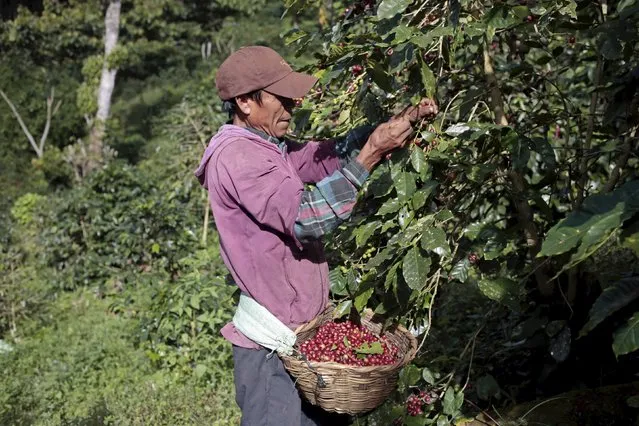
A man from the Nicaraguan ethnic tribe Sumos picks coffee berries at the Nogales farm in Jinotega, Nicaragua January 7, 2016. Soaring temperatures in Central America due to climate change are forcing farmers to pull up coffee trees and replace them with cocoa, spurring a revival in the cultivation of a crop once so essential to the region's economy. (Photo by Oswaldo Rivas/Reuters)
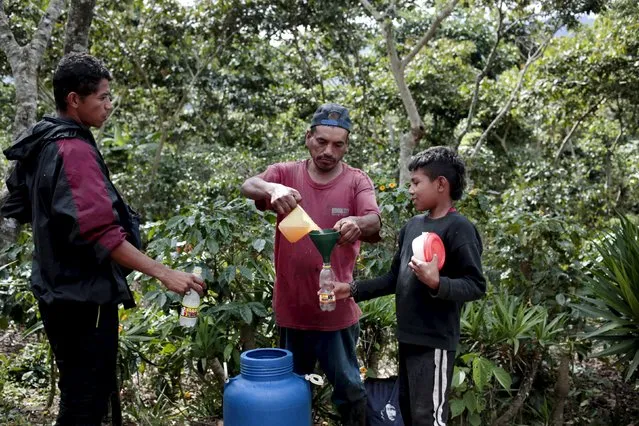
A worker distributes drinks to coffee pickers during a break at the Nogales farm in Jinotega, Nicaragua January 7, 2016. (Photo by Oswaldo Rivas/Reuters)
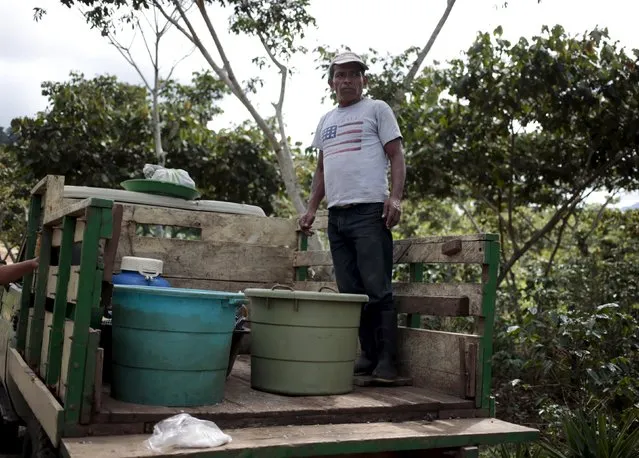
A worker waits for coffee pickers before distributing food at the Nogales farm in Jinotega, Nicaragua January 7, 2016. (Photo by Oswaldo Rivas/Reuters)
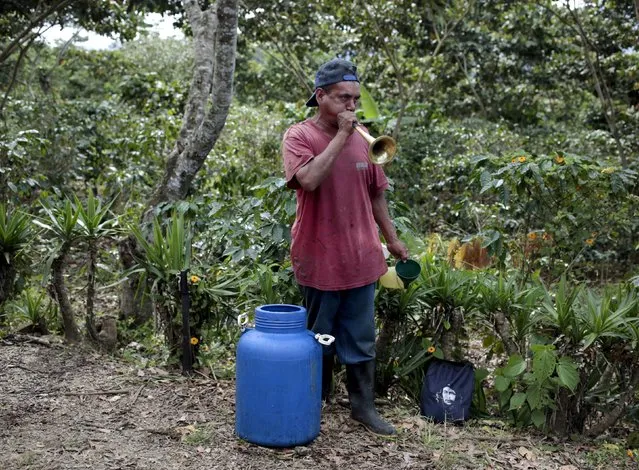
A worker plays a trumpet at the Nogales farm in Jinotega,Nicaragua January 7, 2016. (Photo by Oswaldo Rivas/Reuters)
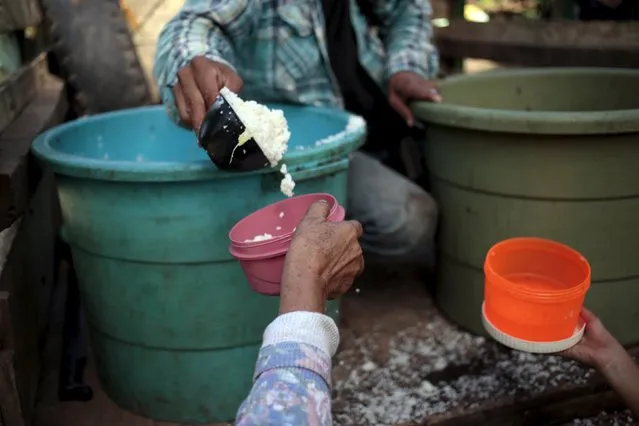
A worker distributes food to coffee pickers during a break at the Nogales farm in Jinotega, Nicaragua January 7, 2016. (Photo by Oswaldo Rivas/Reuters)
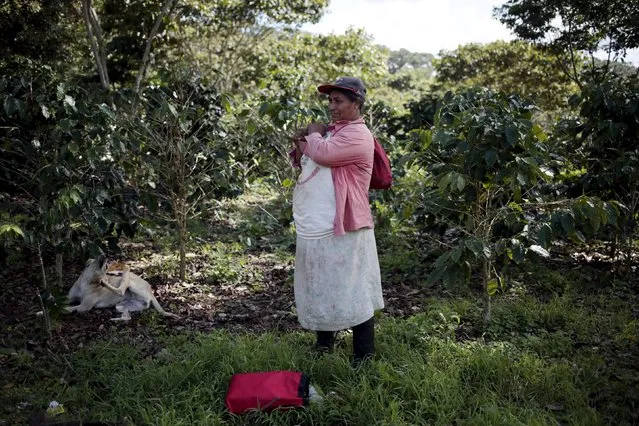
A coffee picker takes a break at the Nogales farm in Jinotega, Nicaragua January 7, 2016. (Photo by Oswaldo Rivas/Reuters)
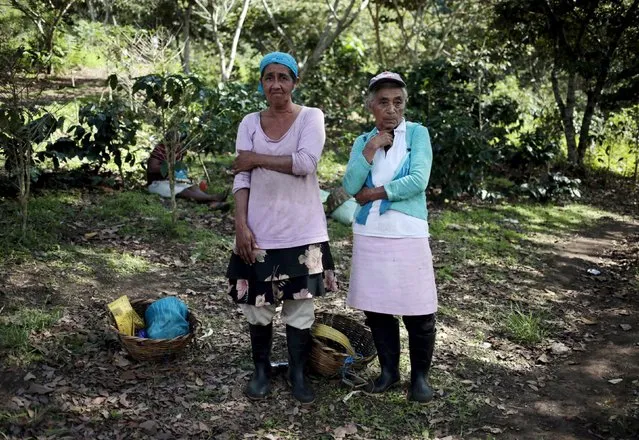
Coffee pickers take a break at the Nogales farm in Jinotega, Nicaragua January 7, 2016. (Photo by Oswaldo Rivas/Reuters)
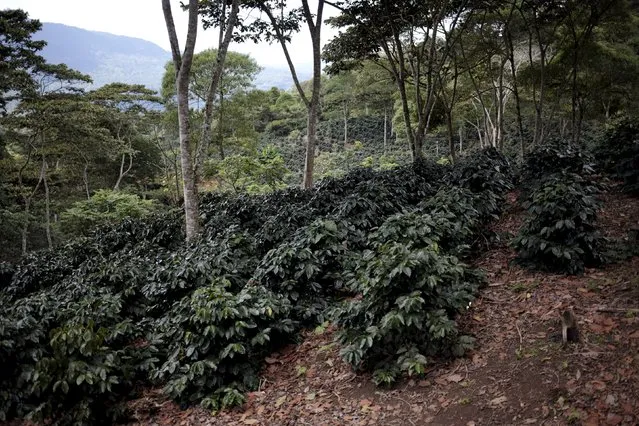
General view of a coffee plantation at the Nogales farm in Jinotega,Nicaragua January 7, 2016. (Photo by Oswaldo Rivas/Reuters)

A man of the Nicaraguan ethnic tribe Miskito picks coffee berries at the Nogales farm in Jinotega,Nicaragua January 7, 2016. (Photo by Oswaldo Rivas/Reuters)
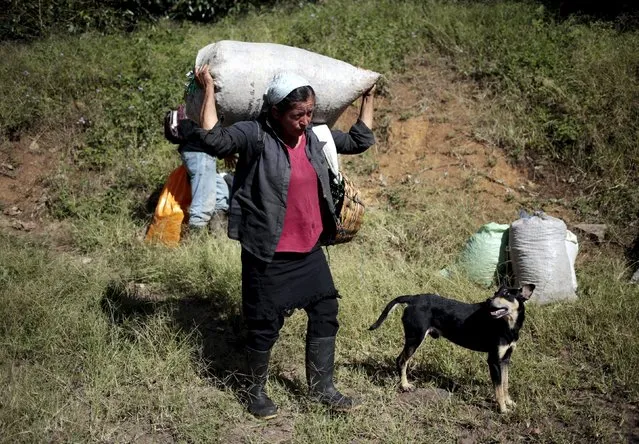
A coffee picker carries sacks of coffee cherries at a plantation in the Nogales farm in Jinotega, Nicaragua January 7, 2016. (Photo by Oswaldo Rivas/Reuters)
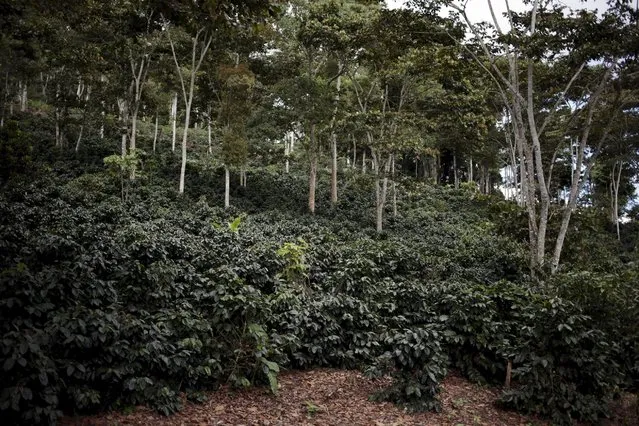
General view of a coffee plantation at the Nogales farm in Jinotega, Nicaragua January 7, 2016. (Photo by Oswaldo Rivas/Reuters)
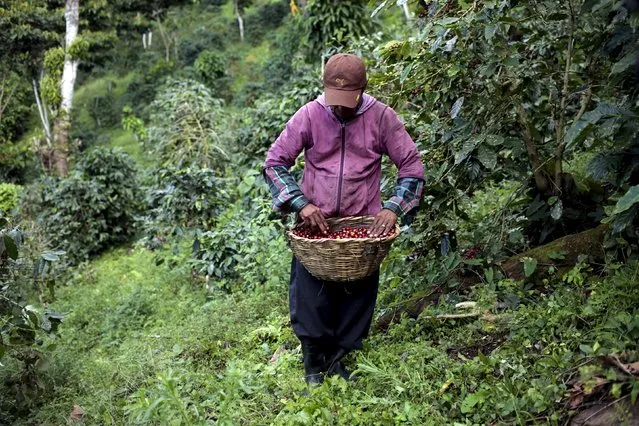
A man of the Nicaraguan ethnic tribe Sumos picks coffee berries at the Nogales farm in Jinotega, Nicaragua January 7, 2016. (Photo by Oswaldo Rivas/Reuters)
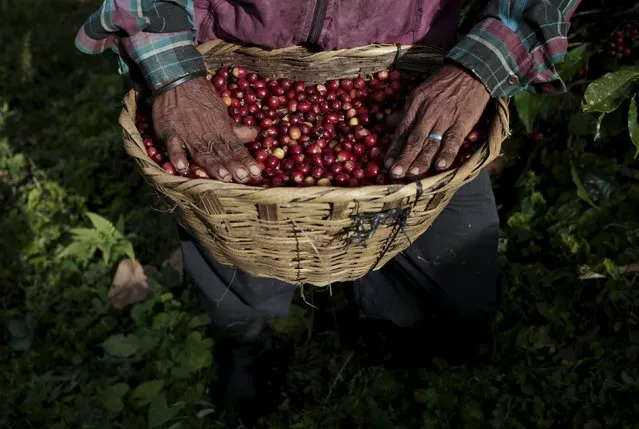
A man of the Nicaraguan ethnic tribe Sumos collects coffee berries at the Nogales farm in Jinotega, Nicaragua January 7, 2016. (Photo by Oswaldo Rivas/Reuters)
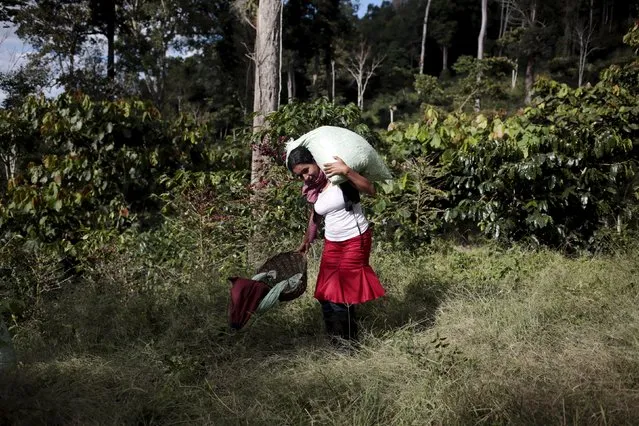
A coffee picker carries sacks of coffee cherries at a plantation in the Nogales farm in Jinotega, Nicaragua January 7, 2016. (Photo by Oswaldo Rivas/Reuters)
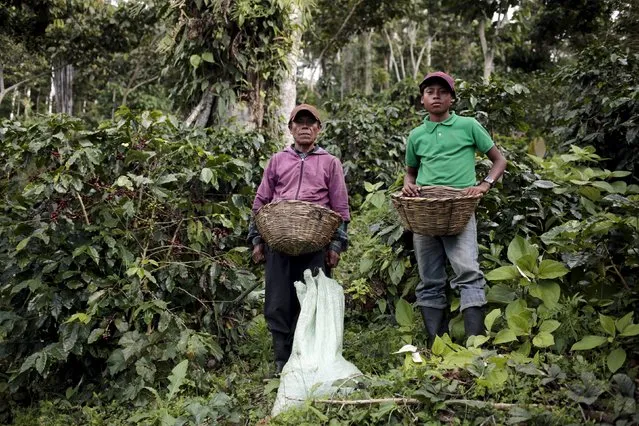
A man and his son, of the Nicaraguan ethnic tribe Sumos, pose for a picture as they pick coffee berries at the Nogales farm in Jinotega, Nicaragua January 7, 2016. (Photo by Oswaldo Rivas/Reuters)
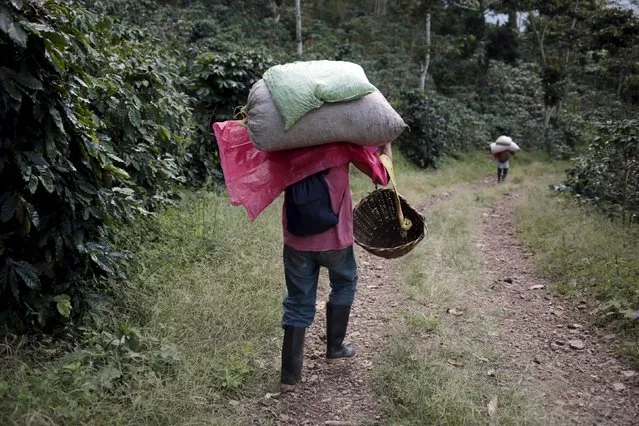
Coffee pickers carry sacks of coffee cherries at a plantation in the Nogales farm in Jinotega, Nicaragua January 7, 2016. (Photo by Oswaldo Rivas/Reuters)
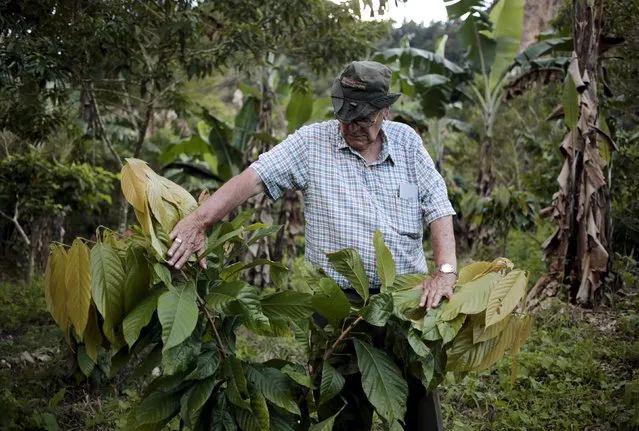
Roger Castellon inspects a cocoa tree at the Nogales farm in Jinotega, Nicaragua January 7, 2016. (Photo by Oswaldo Rivas/Reuters)
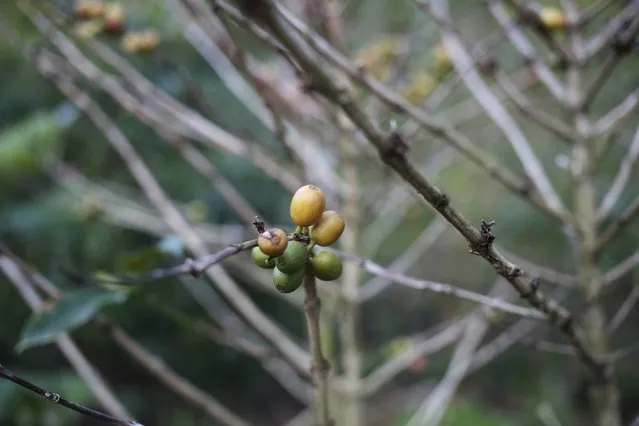
A coffee plant with coffee beans and Roya-infected leaves are seen at a plantation in the Nogales farm in Jinotega, Nicaragua January 7, 2016. (Photo by Oswaldo Rivas/Reuters)
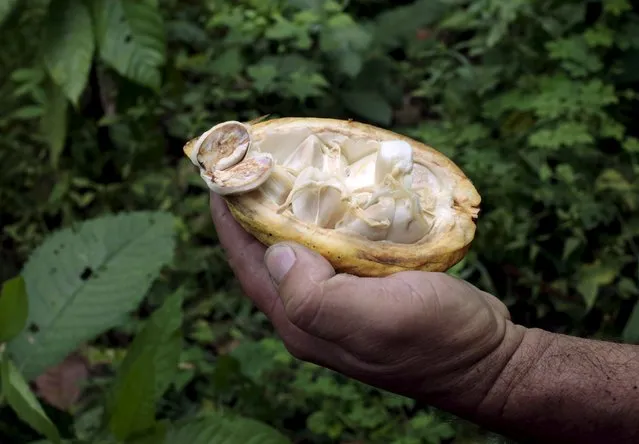
A farmer holds a cocoa pod for the camera in a plantation at the San Miguel farm in Matagalpa, Nicaragua January 8, 2016. (Photo by Oswaldo Rivas/Reuters)
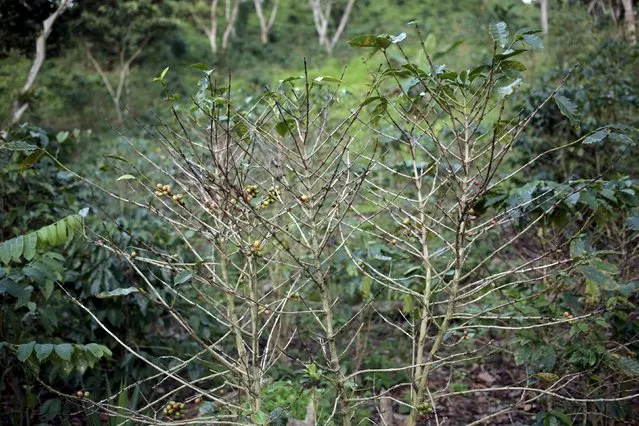
A coffee plant with coffee beans and Roya-infected leaves are seen at a plantation in the Nogales farm in Jinotega, Nicaragua January 7, 2016. (Photo by Oswaldo Rivas/Reuters)
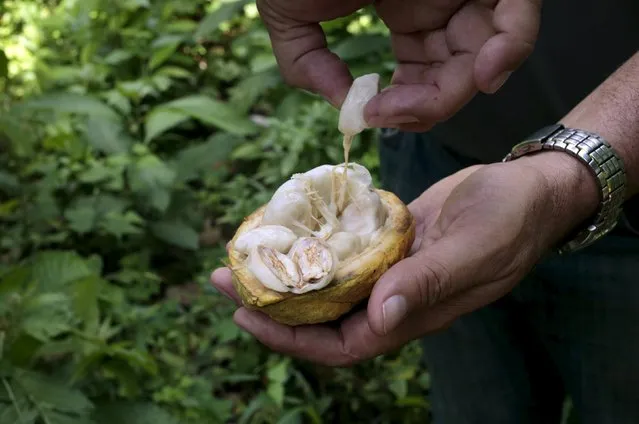
A farmer holds a cocoa pod for the camera in a plantation at the San Miguel farm in Matagalpa, Nicaragua January 8, 2016. (Photo by Oswaldo Rivas/Reuters)
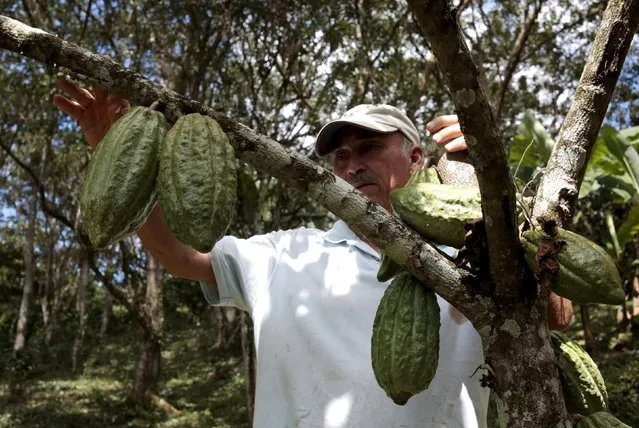
A farmer stands near cocoa fruit in a cocoa plantation at the San Miguel farm in Matagalpa, Nicaragua January 8, 2016. (Photo by Oswaldo Rivas/Reuters)
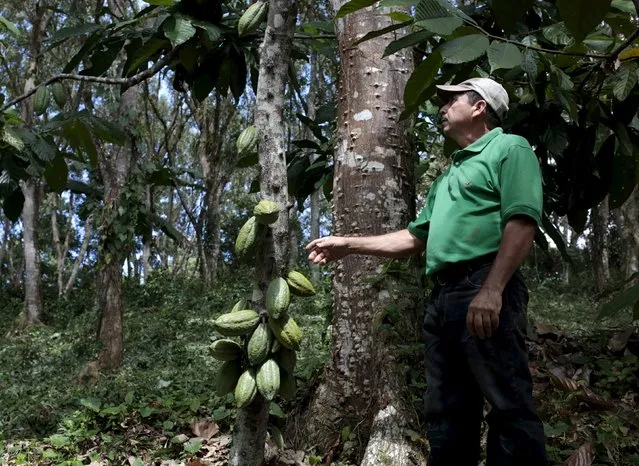
A farmer stands near cocoa fruit in a cocoa plantation at the San Miguel farm in Matagalpa, Nicaragua January 8, 2016. (Photo by Oswaldo Rivas/Reuters)
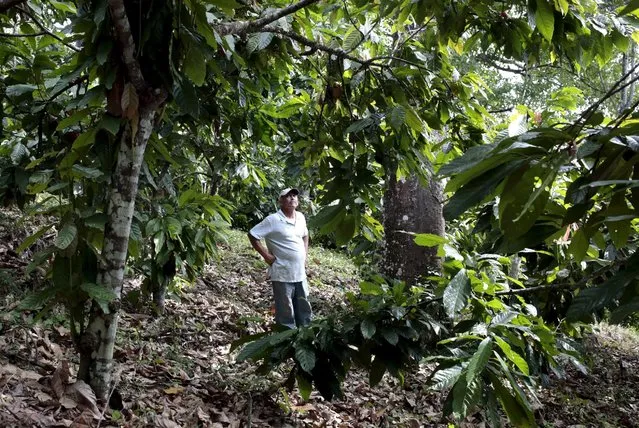
A farmer stands in a cocoa plantation at the San Miguel farm in Matagalpa, Nicaragua January 8, 2016. (Photo by Oswaldo Rivas/Reuters)
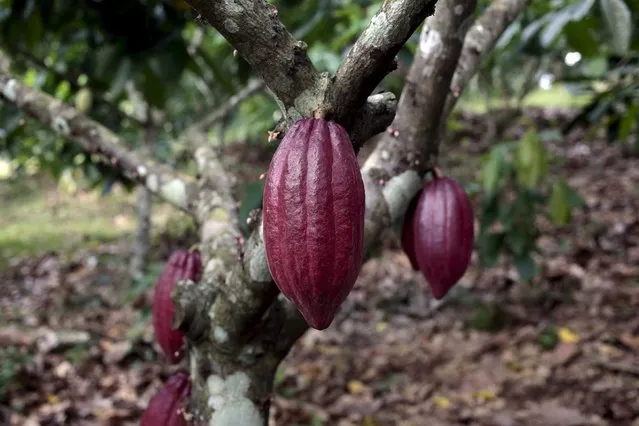
Ripe cocoa pods are seen in a cocoa plantation at the San Miguel farm in Matagalpa, Nicaragua January 8, 2016. (Photo by Oswaldo Rivas/Reuters)
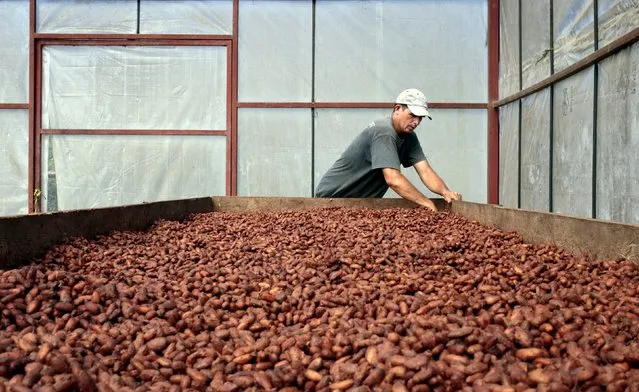
A worker dries cocoa beans at the “Jorge Salazar” Cooperative in the town El Tule in Matagalpa, Nicaragua January 8, 2016. (Photo by Oswaldo Rivas/Reuters)
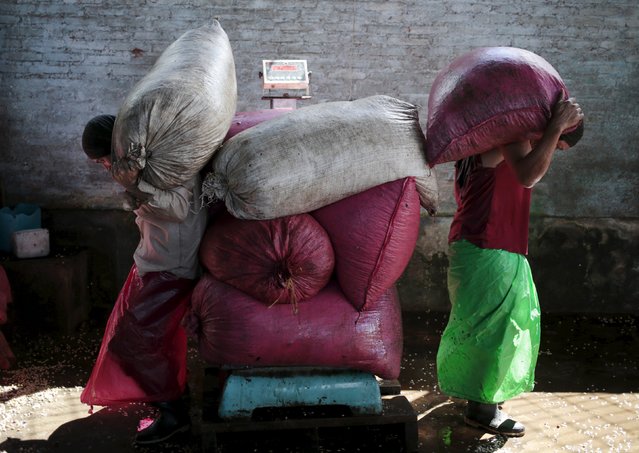
Workers carry sacks of coffee beans at a warehouse at the Nogales farm in Jinotega, Nicaragua January 7, 2016. (Photo by Oswaldo Rivas/Reuters)
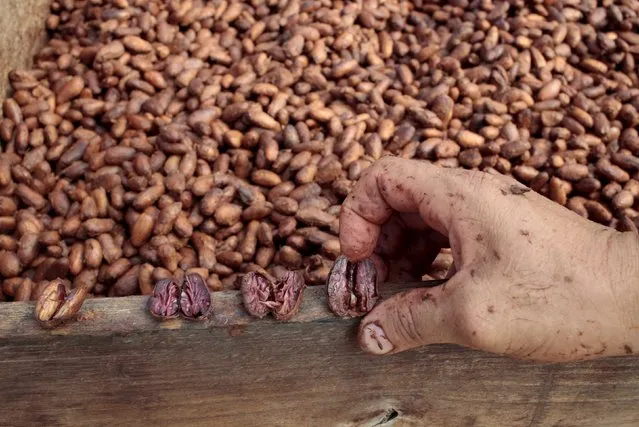
A worker shows cocoa beans at the “Jorge Salazar” Cooperative in the town El Tule in Matagalpa, Nicaragua January 8, 2016. (Photo by Oswaldo Rivas/Reuters)
Farmers across the region, known for high-quality arabica beans, are still recovering from a coffee leaf rust disease known as roya, which devastated crops over the past four years. Now, lower-altitude areas are becoming unsuitable for growing coffee as temperatures heat up. Cocoa thrives in the warmer weather. Castellon maintains coffee plants on the higher portions of his farm, at about 1,200 meters (3,937 feet). But two years ago he replaced coffee with cocoa on 84 hectares (208 acres) of land at about 700 meters (2,297 feet) in altitude, protected by the shade of fig and banana trees. He expects to produce his first cocoa crop this April and said planting the cocoa trees cost about a third of what it would have cost to renew coffee plants.
The quiet shift across the region shows up in export data: This crop year, coffee bean exports from six countries in the region excluding Honduras will fall for the third straight year, to 8.14 million 60-kg (132-pound) bags – the lowest level since the 1973/1974 cycle, according to the U.S. Department of Agriculture. Cocoa production and exports have steadily risen. In Nicaragua, cocoa exports totaled 3,839 tons (8.5 million pounds) in 2015, up more than 80 percent from 2014, and in El Salvador, a coalition is working to expand cocoa acreage hundredfold. Even in Honduras, which has seen a successful recovery from roya, the government is requiring growers to substitute 8 percent of coffee land to cocoa. To be sure, some new cocoa acreage has come from abandonment of other crops, and high-altitude coffee production is strong in many parts of the region. Central America also will not supplant West Africa as the leading supplier of the main ingredient in chocolate anytime soon”. – Luc Cohen and Ivan Castro via Reuters

A man from the Nicaraguan ethnic tribe Sumos picks coffee berries at the Nogales farm in Jinotega, Nicaragua January 7, 2016. Soaring temperatures in Central America due to climate change are forcing farmers to pull up coffee trees and replace them with cocoa, spurring a revival in the cultivation of a crop once so essential to the region's economy. (Photo by Oswaldo Rivas/Reuters)

A worker distributes drinks to coffee pickers during a break at the Nogales farm in Jinotega, Nicaragua January 7, 2016. (Photo by Oswaldo Rivas/Reuters)

A worker waits for coffee pickers before distributing food at the Nogales farm in Jinotega, Nicaragua January 7, 2016. (Photo by Oswaldo Rivas/Reuters)

A worker plays a trumpet at the Nogales farm in Jinotega,Nicaragua January 7, 2016. (Photo by Oswaldo Rivas/Reuters)

A worker distributes food to coffee pickers during a break at the Nogales farm in Jinotega, Nicaragua January 7, 2016. (Photo by Oswaldo Rivas/Reuters)

A coffee picker takes a break at the Nogales farm in Jinotega, Nicaragua January 7, 2016. (Photo by Oswaldo Rivas/Reuters)

Coffee pickers take a break at the Nogales farm in Jinotega, Nicaragua January 7, 2016. (Photo by Oswaldo Rivas/Reuters)

General view of a coffee plantation at the Nogales farm in Jinotega,Nicaragua January 7, 2016. (Photo by Oswaldo Rivas/Reuters)

A man of the Nicaraguan ethnic tribe Miskito picks coffee berries at the Nogales farm in Jinotega,Nicaragua January 7, 2016. (Photo by Oswaldo Rivas/Reuters)

A coffee picker carries sacks of coffee cherries at a plantation in the Nogales farm in Jinotega, Nicaragua January 7, 2016. (Photo by Oswaldo Rivas/Reuters)

General view of a coffee plantation at the Nogales farm in Jinotega, Nicaragua January 7, 2016. (Photo by Oswaldo Rivas/Reuters)

A man of the Nicaraguan ethnic tribe Sumos picks coffee berries at the Nogales farm in Jinotega, Nicaragua January 7, 2016. (Photo by Oswaldo Rivas/Reuters)

A man of the Nicaraguan ethnic tribe Sumos collects coffee berries at the Nogales farm in Jinotega, Nicaragua January 7, 2016. (Photo by Oswaldo Rivas/Reuters)

A coffee picker carries sacks of coffee cherries at a plantation in the Nogales farm in Jinotega, Nicaragua January 7, 2016. (Photo by Oswaldo Rivas/Reuters)

A man and his son, of the Nicaraguan ethnic tribe Sumos, pose for a picture as they pick coffee berries at the Nogales farm in Jinotega, Nicaragua January 7, 2016. (Photo by Oswaldo Rivas/Reuters)

Coffee pickers carry sacks of coffee cherries at a plantation in the Nogales farm in Jinotega, Nicaragua January 7, 2016. (Photo by Oswaldo Rivas/Reuters)

Roger Castellon inspects a cocoa tree at the Nogales farm in Jinotega, Nicaragua January 7, 2016. (Photo by Oswaldo Rivas/Reuters)

A coffee plant with coffee beans and Roya-infected leaves are seen at a plantation in the Nogales farm in Jinotega, Nicaragua January 7, 2016. (Photo by Oswaldo Rivas/Reuters)

A farmer holds a cocoa pod for the camera in a plantation at the San Miguel farm in Matagalpa, Nicaragua January 8, 2016. (Photo by Oswaldo Rivas/Reuters)

A coffee plant with coffee beans and Roya-infected leaves are seen at a plantation in the Nogales farm in Jinotega, Nicaragua January 7, 2016. (Photo by Oswaldo Rivas/Reuters)

A farmer holds a cocoa pod for the camera in a plantation at the San Miguel farm in Matagalpa, Nicaragua January 8, 2016. (Photo by Oswaldo Rivas/Reuters)

A farmer stands near cocoa fruit in a cocoa plantation at the San Miguel farm in Matagalpa, Nicaragua January 8, 2016. (Photo by Oswaldo Rivas/Reuters)

A farmer stands near cocoa fruit in a cocoa plantation at the San Miguel farm in Matagalpa, Nicaragua January 8, 2016. (Photo by Oswaldo Rivas/Reuters)

A farmer stands in a cocoa plantation at the San Miguel farm in Matagalpa, Nicaragua January 8, 2016. (Photo by Oswaldo Rivas/Reuters)

Ripe cocoa pods are seen in a cocoa plantation at the San Miguel farm in Matagalpa, Nicaragua January 8, 2016. (Photo by Oswaldo Rivas/Reuters)

A worker dries cocoa beans at the “Jorge Salazar” Cooperative in the town El Tule in Matagalpa, Nicaragua January 8, 2016. (Photo by Oswaldo Rivas/Reuters)

Workers carry sacks of coffee beans at a warehouse at the Nogales farm in Jinotega, Nicaragua January 7, 2016. (Photo by Oswaldo Rivas/Reuters)

A worker shows cocoa beans at the “Jorge Salazar” Cooperative in the town El Tule in Matagalpa, Nicaragua January 8, 2016. (Photo by Oswaldo Rivas/Reuters)
20 Jan 2016 08:00:00,
post received
0 comments
